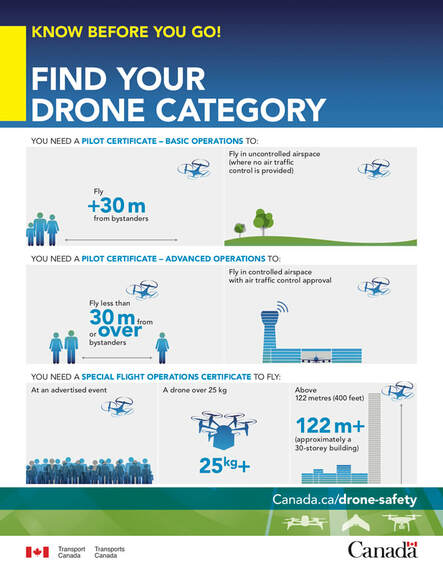|
Nav Canada RPAS Flight Authorization Request Link Flying your Remotely Piloted Aircraft (RPA) in Canadian AirspaceAs of June 1, 2019, new Transport Canada regulations apply to all remotely piloted aircraft (RPA) operating in Canadian airspace. Owners of RPAs (also known as drones or UAVs) must follow the requirements for operating their RPA in each class of Canadian airspace.
What you need to knowAirspace in Canada is classified as controlled or uncontrolled. If you plan to operate in uncontrolled airspace (Class G), you will need a Transport Canada Pilot Certificate – Basic Operations. NAV CANADA does not provide authorization for RPA flights in uncontrolled airspace. If you plan to operate your RPA in controlled airspace (Classes C, D or E) you must have a Transport Canada Pilot Certificate – Advanced Operations and you must obtain a written RPAS Flight Authorization from NAV CANADA, by submitting an RPAS Flight Authorization Request. In addition, all RPA pilots must comply with all applicable legislation, including Canadian Aviation Regulations. For more information, see Transport Canada's Drone Safety page. Submitting an RPAS Flight Authorization Request To submit an RPAS Flight Authorization Request, follow these steps:
0 Comments
On May 15, 2019 j2photography successfully completed the small Advanced RPAS Flight Review. This completes the necessary steps to continue to safely & responsibly operate a RPAS (drone) within and outside of Controlled Airspace as of June 1, 2019 when the Regulations come into effect from Transport Canada.
(Pilot Certificate can be provided upon request) DJI Drones Comply With New Transport Canada Requirements For Advanced Operations
DJI Customers Can Continue Using Drones In Controlled Airspace Without Interruption DJI, the world’s leader in civilian drones and aerial imaging technology, is pleased to declare that nine of its drone models comply with the latest Transport Canada regulations for advanced drone operations in controlled airspace. This allows DJI customers to continue using their preferred drones in these operations after June 1, when Transport Canada’s new regulatory framework for civilian drone operations takes effect across Canada. “Transport Canada wants to ensure that drones operated in advanced missions are high-quality, reliable products. While DJI drones meet our own high quality assurance requirements, we have spent the last few months diligently reviewing our documentation, safety standards and administrative processes to ensure they comply with Transport Canada’s new requirements,” said David Hansell, DJI Public Policy Manager. “We can now declare official compliance with those requirements, allowing our customers to use our drones in controlled airspace without interruption.” Transport Canada announced its new regulatory framework for certain types of advanced civilian drone operations in January, requiring the use of drones whose manufacturer has declared compliance with reliability and operational characteristics under a safety assurance framework. DJI’s compliant drones are the M600 Series, M200 Series, M200 V2 Series, Inspire 2, Mavic 2 series, Mavic Pro, Mavic Air, Phantom 4 series and Spark. “A self-declaration compliance regime is yet another innovative approach by Transport Canada to lead the way in enhancing safety while integrating advanced operations,” said Javier Caina, DJI Director of Technical Standards. “Allowing manufacturers to declare their equipment compliant with requirements and standards is preferable to requiring an aviation authority to certify each product. This approach enables DJI to continue providing new products for our professional customers in Canada so they may continue to innovate, save lives, and develop new use cases while flying safely and responsibly.” DJI continues to review the process of declaring its drones compliant for other advanced operations under Transport Canada’s safety assurance program. These elements of the program have different steps and requirements, and further information will be announced at a later date. DJI supports safe and responsible drone operations, and believes technological improvements, registration systems, online knowledge tests to educate drone pilots, and reasonable restrictions on where drones can fly are the best tools to ensure drones maintain their admirable safety record. DJI has led the industry in developing technology to help enhance the safety of drone operations:
During the USC Conference recently held in Vancouver (Oct 30 2018), Transport Canada provided an update on the proposed changes to Canadian legislation governing UAV/drones, which are now officially called Remotely Piloted Aircraft Systems (RPAS).
No solid date was given on when we will see the final version but they are targeting before end of 2018. Roll-out will be done over a 6 month period once the regulations are published in Canada Gazette Part II. The following is a summary of proposed regulations:
**COURTESY of flitelab.com**  Important things to consider when hiring a UAV operator. - Obviously ask if they are certified. You have every right to ask & the operator should be able to produce their SFOC & the legal documents allowing them to operate at the location & at the time you and they have co-ordinated. - Does the UAV operator have the legal requirements pertaining to there SFOC on hand? ie: safety equipment & personnel. - Has the UAV operator taken into consideration back-up equipment & supplies? ie: should be able to re-power equipment while out in the work area independent of local power grid & should have a back-up UAV that is part of their SFOC (so that it is legal to operate in the event the other becomes unserviceable.) Here at j2 we have taken all of these steps & many more to bring you safe, reliable and honest work. Don't be afraid to ask questions! These are just some things to think about when considering hiring a UAV operator, overall SAFETY is the most important part of any operation. It's not a matter of who is right...it's what is right that counts! HAPPY HALLOWEEN :) |
ABOUT MEI'm all Canadian, lifelong resident of Prince Albert. All Pricing is Subject to Change
& Dates and/or times Requested are Subject to My Availability **Advanced RPAS Exam & Flight Review Successfully Completed.
15/05/2019** **Flight Reviewer Rating completed 05/02/2020** |




